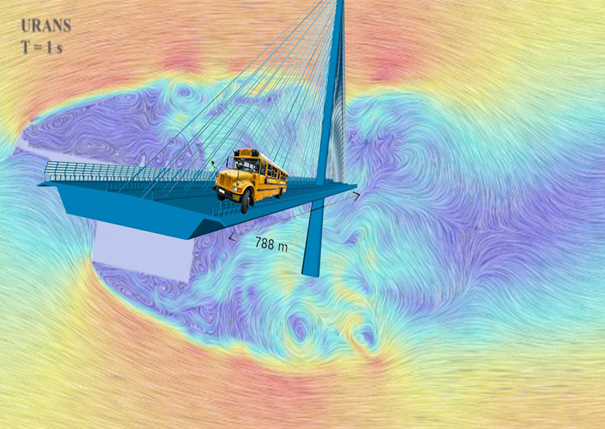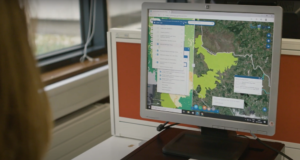Fluid dynamics, wind engineering, bridges, offshore energy, constructed wetlands and archiving women in science and engineering in Ireland with Associate Professor Jennifer Keenahan, School of Civil Engineering.
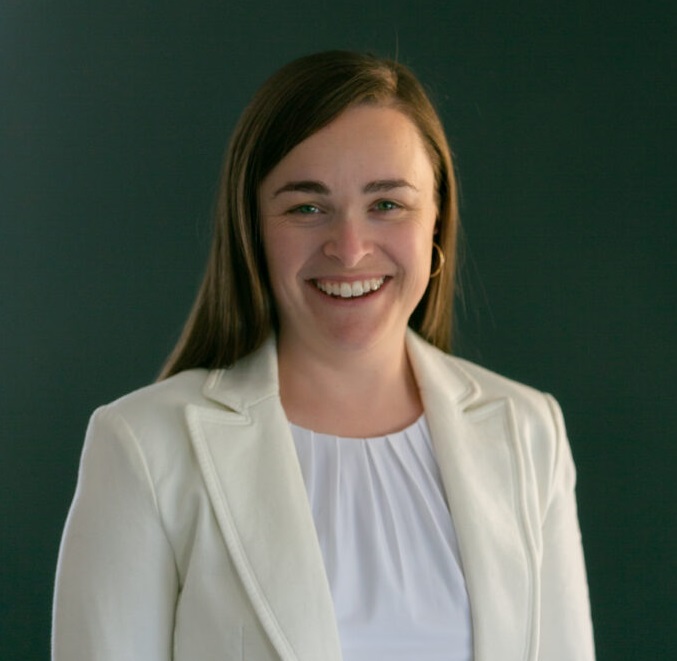
Associate Professor Jennifer Keenahan
UCD School of Civil Engineering
Q: Hello Jennifer. You are in the School of Civil Engineering. Can you tell us a bit about what you currently work on and how you got to this point in your career
A: I’m currently an Associate Professor in Civil Engineering here in UCD and I’ve been here for 8 years. I’ll work backwards – I came to UCD in 2017 from Arup, a big engineering company. I was an engineer there in for three years, on their bridges team initially, and then on their computational modelling team. While I was there, I was also lecturing part time in UCD, so that gave me a connection to the university, which was nice. I really enjoyed the teaching.
Before Arup, I did my PhD in UCD Civil Engineering on bridges, from 2011 to 2014. Before that I did my bachelor’s degree in Civil Engineering in UCD. So I’m very institutionalised, apart from that gap in Arup. Bridges and computational modelling have been key focus points, but I suppose a thread that’s been there the whole time has been the teaching. I’ve always really loved the teaching, and that was a strong draw back to the university.
Q: Often engineering is seen as quite a male-dominated course or career. How did you get into engineering in the first place?
A: I was the last big class before the crash in 2008. There were 140 in my class and of that, maybe 10% were women. So the numbers are quite low. I couldn’t tell you what I had on my CAO. When I sat my Leaving Cert exams, we had the ‘change of mind’ window and my mom sat me down and she said, ‘okay, we’re going to fix your CAO. We’re going to change things, you should put down engineering first’. And of course, I pick up the dictionary and I look up what engineering is because I have no notion. Then I just thought, okay, right? That sounds good. I’ll do that.
Q: Did you like maths and science?
A: I did, well in hindsight I did. My mother knew me better than I knew myself. I always did my maths homework first. I always enjoyed it. I liked it so it was kind of a logical progression. But you can’t know these things when you’re young. So that’s how I got into engineering. Basically, your mom knows better. I changed my CAO and thankfully I got I had enough points, and the rest is kind of history.
Q: So from the start you knew it was something for you.
A: I’d say I was a couple of months into first year and it really clicked with me that I like this. I’m glad I’m doing this. I’m enjoying this, and I certainly find it very easy to get up on a Monday morning and go to work, which I feel very lucky about, because I know that’s not the case for a lot of people.
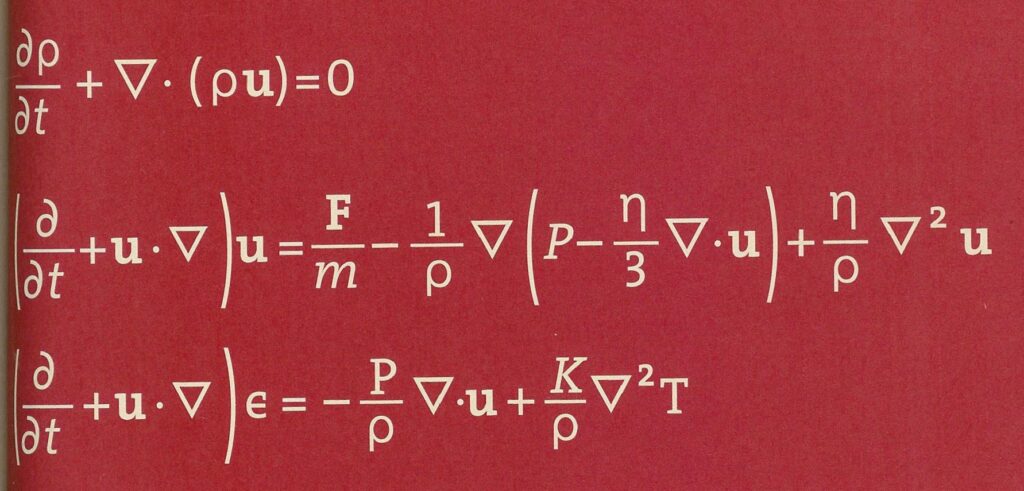
Q: The next question is about the specific field that you work in, computational fluid dynamics. It’s an area that draws in lots of different disciplines, like mathematics for instance. Can you explain a little bit about what fluid dynamics is, and about computational fluid dynamics specifically.
A: Fluid dynamics has a long history in that the equations that underpin it are around as long as Mr. Navier and Mr. Stokes. The Navier-Stokes equations are the fluid dynamics equations. I suppose the bit that is newer or more recent is this is this new world of computational fluid dynamics. It’s really only recent, because we’ve got computers that are better now. They’ve got greater capacity to run big and fast simulations.
There’s an interesting overlap of different disciplines, because there’s a big portion of mathematics that likes to study these Navier-Stokes equations, these fluid equations, because they’re equations, and mathematicians love that. But then there’s also a big portion of engineering that is interested in fluid dynamics and fluid behaviour – because fluids and liquids and water are such a big part of what an engineer works with. It’s quite cross disciplinary, and that’s before you get into the applications.
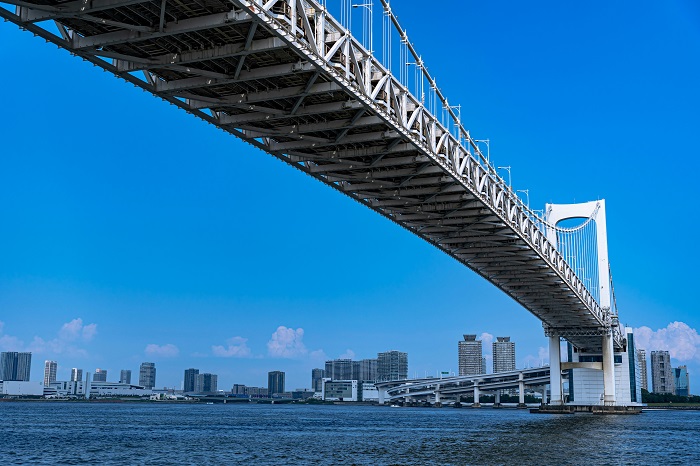
“Computational fluid dynamics offers a great opportunity to understand behaviour of systems. For example a large bridge that’s exposed to certain wind conditions. You know, it’s not necessarily trivial or easy to study that in the real world because it’s on a massive scale, and you can’t fit it inside the laboratory. “
Q. What are some of the applications?
A: Computational fluid dynamics offers a great opportunity to understand behaviour of systems. For example a large bridge that’s exposed to certain wind conditions. You know, it’s not necessarily trivial or easy to study that in the real world because it’s on a massive scale, and you can’t fit it inside the laboratory. Computational fluid dynamics allows us to study that which is of benefit academically, but also to industry. There’s lots of exciting opportunities.
I guess where computational fluid dynamics can complement the more traditional methods is where we might have field data from let’s say, sensors that are deployed in in in the field, and you could use that to validate the computer simulation. Or you might have an experimental model that you could use to as a validation of the of the simulation. Then you can have greater confidence that the simulation is doing something sensible and meaningful for what you’re looking at.
Q: So this is the cutting edge of fluid dynamics, this integration of computational data?
A: I would say it’s been around in some industries for a while. For instance, in Formula One, but we’re only recently moving into more civil engineering application, as in the more bread and butter design as opposed to the big money making kind of work. NASA would have used it for a good bit in terms of airspace and air travel.
Q: What kind of applications does it have, and what have you explored in your own work and research?
A: Well, you can use computational fluid dynamics to represent fire and smoke, which brings into the whole fire engineering piece. You can also use it to model noise, so then you’re bringing in acoustic people. You can use it to model air, wind and air flow, hot air and cold air, air-conditioning systems, for example. Then also you can use it to model fluids. So that will be your water, oil that type of thing. Very rapidly, it becomes like a hyper, disciplinary, transdisciplinary topic, and that that can bring in lots of different people from different backgrounds.
One of the applications that I got interested in in the beginning was wind bridge behaviour, because I was originally a bridge engineer. That involves treating the wind as a fluid and treating the bridge as an object or a structure. You’re interested in questions like, at what point will my vehicle overturn on the bridge because it’s exposed to the wind? Or are there certain potential future climate scenarios where this bridge becomes unsafe because of wind? Do I need to impose speed restrictions on vehicles during orange weather warnings, that kind of thing.
These are things that we can now explore with this type of modelling that would have been almost impossible to explore before because you’re not going to risk people’s lives, putting them on a bridge in high wind to test what happens. The default would have been to close the bridge whereas this offers us an opportunity to do more new sophisticated analysis.
“These are things that we can now explore with this type of modelling that would have been almost impossible to explore before because you’re not going to risk people’s lives, putting them on a bridge in high wind to test what happens. The default would have been to close the bridge whereas this offers us an opportunity to do more new sophisticated analysis.”
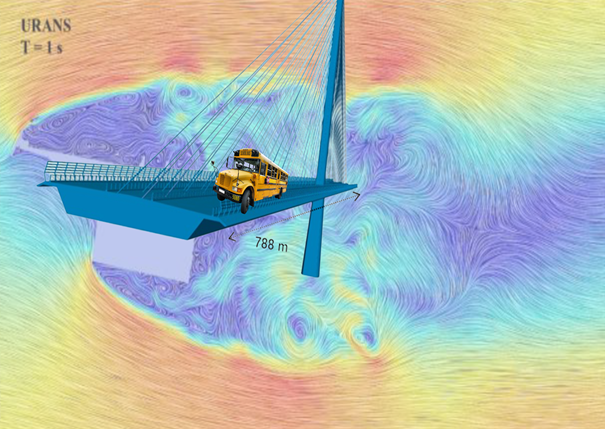
Some other areas where I have been using CFD in research would be things like offshore renewable energy installations. Where you have to do the foundation of your offshore wind turbine. How do you make sure that the water flow isn’t going to cause scour and erosion of the sand around the foundation. I have a couple of different students looking at different anchor types and different seabed size conditions and what we can learn about that and I’m part of the MARSEA group, funded through the Earth Institute, which looks at the complex interaction between geological, oceanographic, environmental and biological factors that control the evolution of the seafloor.
I also have somebody else looking at shipwrecks, which is interesting, and coastal environments, so how future wind conditions can affect coastal habitats for animals and the ecology of the area. When there’s air or water involved, it can be modelled using CFD. It’s just kind of a case of understanding the context and applying the principles of physics and maths to that setup and that application.
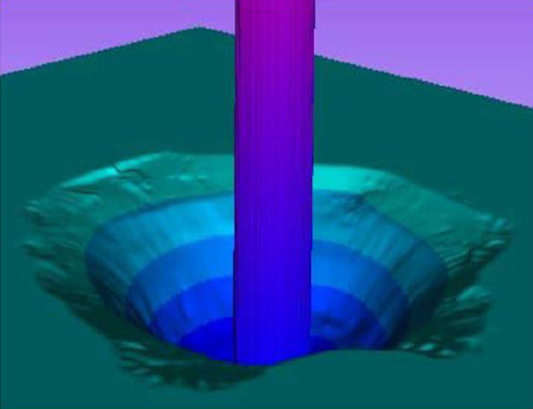
“How do you make sure that the water flow isn’t going to cause scour and erosion of the sand around the foundation. I have a couple of different students looking at different anchor types and different seabed size conditions and what we can learn about that and I’m part of the MARSEA group, funded through the Earth Institute, which looks at the complex interaction between geological, oceanographic, environmental and biological factors that control the evolution of the seafloor.”
Q: How does your work interact with climate change and its impact on the environment?
A: There’s a really nice link between my work and climate change, in the sense that in everything that I do with the modelling there’s the opportunity to do ‘what if’ scenarios. So you can set up a model with the normal wind conditions on a particular bridge or the usual tidal flows, or whatever. But then you could also set it up to say, well, this is the one in a hundred year wind event that might happen in a climate change scenario. Then you can test that, and you can look at it and see what happens.
There’s actually a huge opportunity to do this kind of predictive modelling, this kind of anticipatory work. I enjoy that. Generally speaking, if we’re expecting higher wind conditions because of climate change then higher winds means we need our buildings and our structures to be stronger. Stronger means more material. More material means more carbon and more carbon means worse climate change. More climate change means higher winds, which means needing stronger buildings… so there is a feedback loop. In attempts to make things stronger and sufficiently designed for future climate change, we’re actually going to end up with a higher carbon footprint. It’s a challenge – I don’t have the solution. Nobody has the solution.
“There’s actually a huge opportunity to do this kind of predictive modelling, this kind of anticipatory work. I enjoy that. Generally speaking, if we’re expecting higher wind conditions because of climate change then higher winds means we need our buildings and our structures to be stronger. Stronger means more material. More material means more carbon and more carbon means worse climate change. More climate change means higher winds, which means needing stronger buildings… so there is a feedback loop.”
Q: I spotted that you do some work on constructed wetlands, and wanted to ask you about that as kind of nature based solution at the intersection of engineering and natural processes. Can you tell us about your work on this?
A: That was a really nice project. A colleague and I supervised a PhD student on this topic of constructed wetlands. They were designing, or optimising maybe is the better word – they were optimising the design of constructed wetlands, from the perspective of treatment efficiency. So, if we change the geometry of the wetland, does that mean a better efficiency of treatment? Do we need less treatment chemicals? If we put in aeration units here and here and here and here, does that improve the treatment efficiency?
It was brilliant because it was a mixture of CFD modelling and experiments in the lab. We could do some problem solving or some learning with the CFD. And then, when you had done that homework, then you picked the best one, and that’s the one you built in the lab. The CFD results and the experimental results were really well matched. We found that increasing the number of baffles in the constructed wetland has a stronger effect than extending baffle length on residence time distributions, delivering up to a 58% gain in hydraulic efficiency.
It was a co-supervision. The expertise I brought was the computational modelling, and then the other supervisor was expert in the wastewater treatment. We had complementary backgrounds. We each brought something to the student, and it was quite interesting. I know a lot more now constructed wetlands. The student on the project was phenomenal, they published five papers.
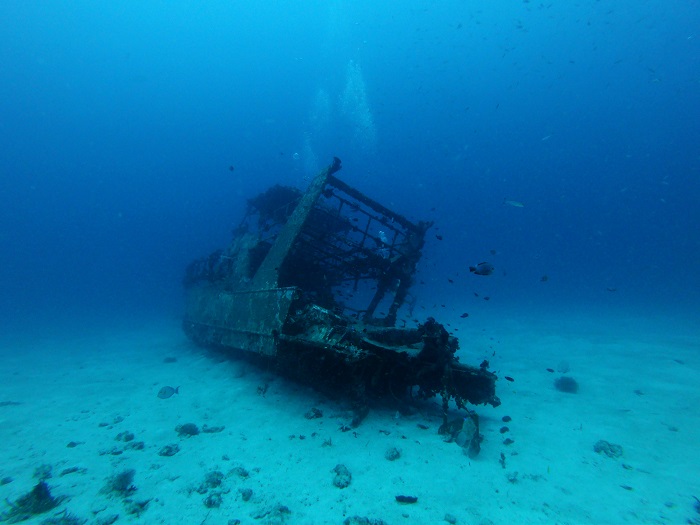
Shipwrecks were another interesting thing I looked at. One goal is to understand potential for pollution. If you’ve got these shipwrecks that went down, and they’ve got barrels of oil, or they’ve got barrels of God knows what inside them. Over time the shipwreck is going to degrade. If it was made of wood, it’s going to crumble eventually, and it’ll corrode and will pollute the environment. There’s a question around which shipwrecks are at the greatest risk. Is the water in that area relatively stationary? Is it stagnant? Is it tidal. Is it moving all the time? Where would the oil end up?
Q: Engineering can be very applied outside of academia yet it also interacts with lots of other more fundamental disciplines within the university. What draws you to engineering and to the teaching of engineering?
A: I mean, I think I’ll be totally biased. But I think engineers are amazing. I think we should have more engineers in government, and we should have more engineers as politicians. That’s why I’m drawn to the teaching and learning perspective and the training of engineers, because that’s, I suppose, a big part of the bread and butter is the lecturing and the teaching. It’s really rewarding training the next generation of engineers, giving them the problem-solving skills, the structured, rational thinking logic.
When I look at my classmates from my degree, and when I look at where our graduates go, it’s so interdisciplinary. You’ve got biomedical engineers that will end up in hospitals, and then you’ll have mechanical engineers that will be designing fridges. You’ll have food engineers, and they’ll be designing like the next type of Easy-Single or whatever you know. It’s so broad, and it’s so multidisciplinary. Academic engineering is probably the most non applied part of engineering.
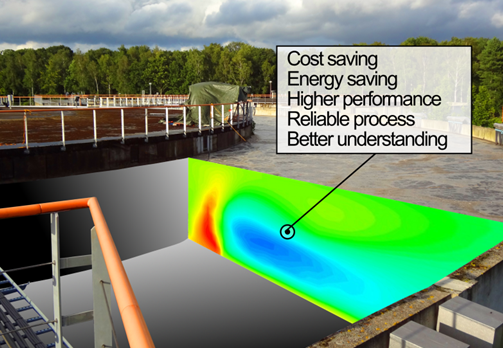
“I think engineers are amazing. I think we should have more engineers in government, and we should have more engineers as politicians. That’s why I’m drawn to the teaching and learning perspective and the training of engineers, because that’s, I suppose, a big part of the bread and butter is the lecturing and the teaching.”
Q: What do you think across all those fields… is there a common thread of ‘engineer thinking’? What links all those engineers? Is it an innate aptitude or can you teach it?
A: I think it’s both. I think it’s true, not just of engineering skills, but of any skills. Some people will be naturally good communicators, and then others are maybe not natural born communicators, but they develop the skills. I think it’s absolutely true for a lot of the engineering skills. Some people will have visual thinking. They’ll have logic. They’ll have rational logic in their mind, and other people, they learn it.
The part I like with the teaching is when you’re working with someone, one on one, and you’re explaining something. And you know the student is not getting it. They’re kind of there with the glazed expression. Then you go, okay, we’ll try this again. I’ll explain it a different way. I’ll draw a picture. And then all of a sudden, you see this like little light bulb go on and then the penny drops in their mind. All of a sudden, they’re like, oh, I get it! I don’t know whether I’m any good at it or not, but I certainly get a buzz out of it.
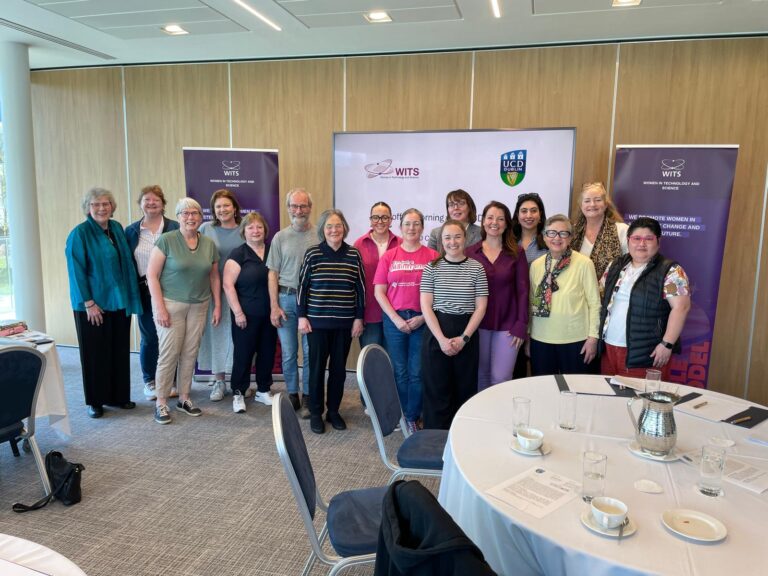
Q: And are you working on any other projects at the moment?
A: I can tell you about something I’m enjoying at the moment. I’m part of Women in Technology and Science Ireland (WITS). WITS is a national voluntary organisation, and I’m their deputy chair at the moment. They’re nearly older than I am. They’re 35 years in in existence, which is quite remarkable for a voluntary organisation. That somebody has passed on the chair, and the secretary and the treasurer every year. I took this notion that there must be an archive of AGMs. The more I thought about this, and the more I started asking people – they would say, I’ve got a box of stuff in my house. I’ve got a box in my attic. I’ve got a box in my shed. I am knee deep in lodging this into UCD archives. I’m really enjoying it, it’s like my zen activity.
Some stuff I have digitally and other things I have in in physical paper. But I have been very systematically contacting 35 years worth of board members and executive members and asking, do you think you might have any photographs? Do you have any newsletters? Do you have any minutes of meetings? It kind of feels like there’s an important purpose to it, because, you know, it risks not getting done and being lost. Of the database of a hundred or 150 people that I’ve got so far of people that were involved, maybe 5 or 6 of them have passed away. But almost all of them are still living, which is kind of remarkable.
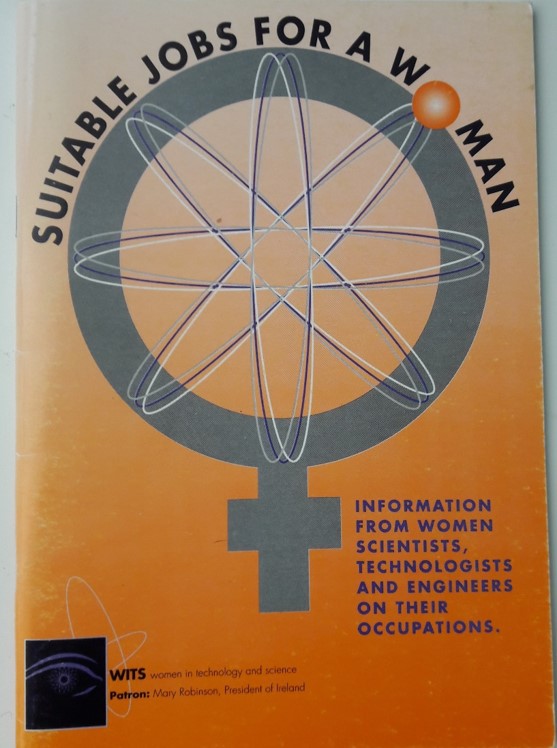

My step two, in all the spare time that I don’t have, I’m thinking of an oral histories project, before those people go. Liz Bruton who worked at the Earth Institute prompted me to do this, we both did the national oral history training over the summer last year. After that we did a pilot interview to see how it would go and how it would work. It would be really good to keep going with that. I’d love to find some funding and take on a research assistant, throw some resources at it.
One of the things we’ve done is an exhibition of the stuff that we have found in the archive so far, the stuff that we’ve collected. One of the items was called the Talent Bank, it was a publication, almost like a phone directory of very highly qualified women in science and engineering who would be available for media interviews and newspaper articles. That was from 2002. Then I found another publication they had, which was in 1993, and it was called Suitable Jobs for Women.
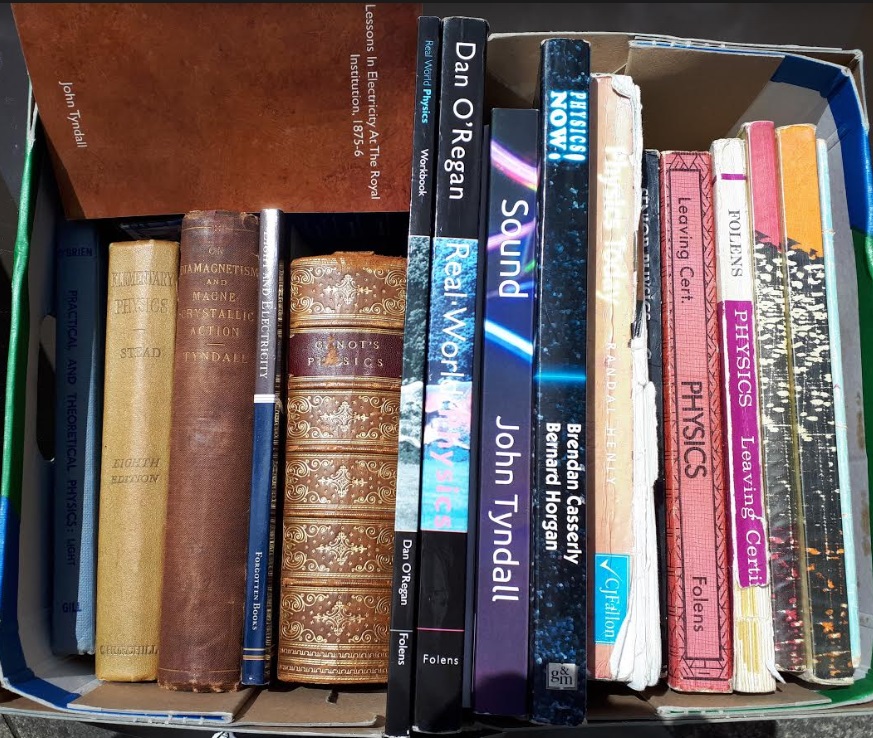
“My dad taught physics as a teacher in secondary school, and he had every single copy going back for 160 years. We wrote a paper which was about 160 years of physics leaving cert textbooks. We did an analysis of them, and how they changed over 160 years, and going all the way back to like Tyndall in the 1860s.”
Q: I also saw you did something with physics textbooks as well, a history of science type project?
A: Yes, that was a project I did with my dad. It happened because I was on maternity leave in the lockdown in 2020, and we were all losing our marbles as we couldn’t leave the house. I was in my parents’ house one day, the baby was asleep and I was bored out of my mind. I started helping Dad to declutter the attic. And at a certain point we find this box, this cardboard box of books and they’re all physics textbooks. I asked my dad, why have you got so many leaving cert physics textbooks? He taught physics as a teacher in secondary school, but basically he had every single copy going back for 160 years. We wrote a paper which was about 160 years of physics leaving cert textbooks. We did an analysis of them, and how they changed over 160 years, and going all the way back to like Tyndall in the 1860s.
I’m definitely drawn to the historical, cultural and social life of engineering because every calculation sits inside a story of people and place, and that is what gives the technical work purpose, energy and heart.
